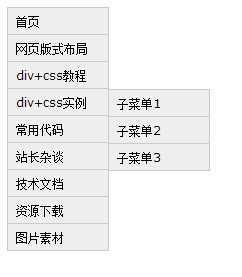标签:style blog http java color 使用
<!DOCTYPE html PUBLIC "-//W3C//DTD XHTML 1.0 Transitional//EN" "http://www.w3.org/TR/xhtml1/DTD/xhtml1-transitional.dtd"> <html xmlns="http://www.w3.org/1999/xhtml"> <head> <meta http-equiv="Content-Type" content="text/html; charset=utf-8" /> <script type="text/javascript"><!--//--><![CDATA[//><!-- startList = function() { if (document.all&&document.getElementById) { navRoot = document.getElementById("menu"); var allli = navRoot.getElementsByTagName("li") for (i=0; i<allli.length; i++) { node = allli[i]; node.onmouseover=function() { this.className+=" current"; } node.onmouseout=function() { this.className=this.className.replace(" current", ""); } } } } window.onload=startList; //--><!]]></script> <style type="text/css"> body { font-family: Verdana; font-size: 12px; line-height: 1.5; } img { border-style: none; } a { color: #000; text-decoration: none; } a:hover { color: #F00; } #menu { width: 100px; border: 1px solid #CCC; border-bottom:none;} #menu ul { list-style: none; margin: 0px; padding: 0px; } #menu ul li { background: #eee; padding: 0px 8px; height: 26px; line-height: 26px; border-bottom: 1px solid #CCC; position:relative; } #menu ul li ul { display:none; position: absolute; left: 100px; top: 0px; width:100px; border:1px solid #ccc; border-bottom:none; } #menu ul li.current ul { display:block;} #menu ul li:hover ul { display:block;} </style> </head> <body> <div id="menu"> <ul> <li><a href="#">首页</a></li> <li><a href="#">网页版式布局</a> <ul> <li><a href="#">自适应宽度</a></li> <li><a href="#">固定宽度</a></li> </ul> </li> <li><a href="#">div+css教程</a> <ul> <li><a href="#">新手入门</a></li> <li><a href="#">视频教程</a></li> <li><a href="#">常见问题</a></li> </ul> </li> <li><a href="#">div+css实例</a> <ul> <li><a href="#">子菜单1</a></li> <li><a href="#">子菜单2</a></li> <li><a href="#">子菜单3</a></li> </ul> </li> <li><a href="#">常用代码</a></li> <li><a href="#">站长杂谈</a></li> <li><a href="#">技术文档</a></li> <li><a href="#">资源下载</a></li> <li><a href="#">图片素材</a></li> </ul> </div> </body> </html>
如果用JQuery来写上面的JS则更简单:
<!DOCTYPE html PUBLIC "-//W3C//DTD XHTML 1.0 Transitional//EN" "http://www.w3.org/TR/xhtml1/DTD/xhtml1-transitional.dtd"> <html> <head> <meta http-equiv="Content-Type" content="text/html; charset=utf-8" /> <script type="text/javascript" src="jquery-1.7.2.min.js"></script> <style type="text/css"> body { font-family: Verdana; font-size: 12px; line-height: 1.5; } img { border-style: none; } a { color: #000; text-decoration: none; } a:hover { color: #F00; } #menu { width: 100px; border: 1px solid #CCC; border-bottom:none;} #menu ul { list-style: none; margin: 0px; padding: 0px; } #menu ul li { background: #eee; padding: 0px 8px; height: 26px; line-height: 26px; border-bottom: 1px solid #CCC; position:relative; } #menu ul li ul { display:none; position: absolute; left: 100px; top: 0px; width:100px; border:1px solid #ccc; border-bottom:none; } /*这里就不需要定义这个样式了,使用JQuery的togger方法即可*/ /* #menu ul li.current ul { display:block;} #menu ul li:hover ul { display:block;} */ </style> <script type="text/javascript"> $(function(){ $("#menu li").bind({ mouseover: function() { $(this).children("ul").toggle(); }, mouseout: function() { $(this).children("ul").toggle(); } }); }); </script> </head> <body> <div id="menu"> <ul> <li><a href="#">首页</a></li> <li><a href="#">网页版式布局</a> <ul> <li><a href="#">自适应宽度</a></li> <li><a href="#">固定宽度</a></li> </ul> </li> <li><a href="#">div+css教程</a> <ul> <li><a href="#">新手入门</a></li> <li><a href="#">视频教程</a></li> <li><a href="#">常见问题</a></li> </ul> </li> <li><a href="#">div+css实例</a> <ul> <li><a href="#">子菜单1</a></li> <li><a href="#">子菜单2</a></li> <li><a href="#">子菜单3</a></li> </ul> </li> <li><a href="#">常用代码</a></li> <li><a href="#">站长杂谈</a></li> <li><a href="#">技术文档</a></li> <li><a href="#">资源下载</a></li> <li><a href="#">图片素材</a></li> </ul> </div> </body> </html>
效果如下:

这里UL和LI的布局的核心参见:DIV布局之positioan详解
DIV+CSS布局重新学习之css控制ul li实现2级菜单,布布扣,bubuko.com
DIV+CSS布局重新学习之css控制ul li实现2级菜单
标签:style blog http java color 使用
原文地址:http://www.cnblogs.com/yangzhilong/p/3811992.html